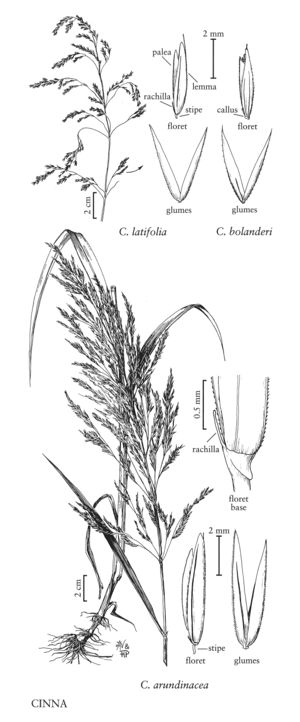Difference between revisions of "Cinna bolanderi"
FNA>Volume Importer |
imported>Volume Importer |
||
| Line 4: | Line 4: | ||
|publications= | |publications= | ||
|common_names=Sierran woodreed;Bolander's woodreed | |common_names=Sierran woodreed;Bolander's woodreed | ||
| + | |special_status={{Treatment/ID/Special_status | ||
| + | |code=E | ||
| + | |label=Endemic | ||
| + | }} | ||
|basionyms= | |basionyms= | ||
|synonyms= | |synonyms= | ||
| Line 38: | Line 42: | ||
|publication title= | |publication title= | ||
|publication year= | |publication year= | ||
| − | |special status= | + | |special status=Endemic |
| − | |source xml=https:// | + | |source xml=https://bibilujan@bitbucket.org/aafc-mbb/fna-data-curation.git/src/bb6b7e3a7de7d3b7888a1ad48c7fd8f5c722d8d6/coarse_grained_fna_xml/V24/V24_1099.xml |
|subfamily=Poaceae subfam. Pooideae | |subfamily=Poaceae subfam. Pooideae | ||
|tribe=Poaceae tribe Poeae | |tribe=Poaceae tribe Poeae | ||
Revision as of 21:44, 27 May 2020
Culms 85-203 cm; nodes 4-8. Ligules 3.5-7 mm; blades to 40 cm long, 2-19 mm wide. Panicles 7.5-43 cm; branches spreading to ascending. Spikelets (3.6)4-5.5(6.3) mm; rachilla prolongations 0.4-0.9 mm, sometimes absent. Lower glumes (3.3)3.5-5.2(6) mm, 1-veined; upper glumes (3.6)4-5.5(6.3) mm, 1- or 3-veined; stipes essentially absent, florets more or less sessile; lemmas (2.7)3.2-4.6 mm, 5-veined, lateral veins underdeveloped and often faint, awns 0.2-1.5 mm or absent; paleas 2-veined, the veins approximate; anthers 2, 1.2-2.6 mm, rarely to 0.7 mm. Caryopses 2-2.9 mm. 2n = 28.
Discussion
Cinna bolanderi is endemic to meadows and streamsides at 1900-2400 m in Sequoia, Kings Canyon, and Yosemite national parks. It flowers from late summer to fall. It used to be included in C. latifolia, but it differs from that species in having 2 anthers, longer anthers and spikelets, and sessile florets. The two species do not overlap in distribution.
Selected References
None.
